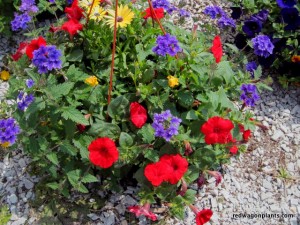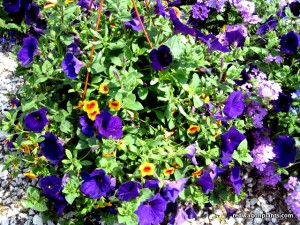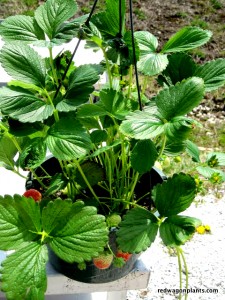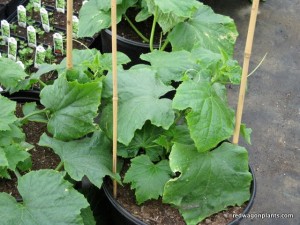IN THE GARDEN August 8, 2025
We are in another dry spell, so here is your friendly reminder to soak all of your containers every morning. Raised beds dry out fairly quickly too, so be sure to give them a deep soak 2 to 3 times a week. It is always better to water deeply once or twice a week rather than to water lightly every day.
We are fertilizing our containers once a week, and alternating with fish emulsion from Neptune’s Harvest and Compost Plus from VT Compost Company. The planters on our bridge are looking great, and this is why. Along with our team of careful waterers who give the plants lots of love every day.
It is a good time to replant lettuce, chicories, broccoli, cabbage, sprouting broccoli, kale, and more! We have new generations of all of these seedlings and also beets, our custom blend of zesty mustard greens, our staff favorite gem lettuces, and so much more.
Are you growing herbs for tea? We have a great selection and it is not too late to get them in the ground and have plenty to dry for winter use. Lemon Verbena and Tulsi (a.k.a holy basil) are staff favorites. And if you already have some herbs growing in the garden, start drying them now. Future you will appreciate curling up with a warm cup of tea this winter. Here is a blog post that will explain how to do it.
And here is another friendly reminder that late summer and early fall are ideal times to plant perennials. The days are cooling down, reducing transplant shock and there is still plenty of time for the plants to set roots and establish themselves before winter comes around. Next spring they’ll be ready to take off. Are you curious about how to take care of perennials at various times of the year? Read this helpful article for more info and resources.
A NOTE FROM JULIE
We get lots of questions about garden pests and diseases, and this year more than ever, we seem to have a slight uptick in concern over what I consider to be tolerable situations. Let me explain.
When you farm or garden ecologically, you are working with living things that have life cycles, threats to their health, symbiotic allies, and opportunistic predators. It is easy to focus just on the problems, and to enter a cycle of worry followed by a desire to fix it.
Here is what I recommend when you have a plant that looks less than optimal.
Assess the problem. Is the damage on just one part of the plant, or is the whole plant affected and weak? Can you trim off the damaged leaf or stem and does that make you feel better? If so, go for it. The plant won’t mind.
Is it a perennial more than a few years old? Does it need to be divided? Just like us, plants age. And while our wrinkles and liver spots are easily recognized as signs of aging, your plant’s flopping and stretching and lack of flowers is trying to tell you the same thing. Unlike us, perennial plants can be refreshed by being cut back, dug up, divided and replanted with more space. If this sounds like too much work, consider your plant selection, and look for plants that do not need to be divided given enough room to grow - Baptisia, Amsonia, Rudbeckia, and many grasses come to mind.
On the flip side, is your plant very young? In the case of shrubs, trees and perennials, they sometimes need a year or two to acclimate, and it is best to recalibrate expectations with the situation and the life cycle of that plant. They are babies in your midst, and it is ok to watch their growing pains without needing to fix them. Be patient.
A certain amount of insect damage is ok. There I said it. A garden can be perfectly healthy and still have a few insect pests. It is a question of balance. Here at RWP, and at home, we never spray to kill insects in the ornamental gardens or our kitchen gardens. We very occasionally use sprays approved for organic production on our herbs and a few of our potted greenhouse plants. In the gardens, we conduct visual checks and hand pick bugs and their eggs on a regular basis. I use row cover as a physical barrier against flea beetles, cucumber beetles, and squash bugs. Caterpillars and insects are part of someone’s food chain, and usually if we let the predators come in and do their job, things can stay in check.
Prevention is key. Good soil, good airflow, water and mulch (in some cases) are your friends. By keeping the plants as healthy and vigorous as possible, they will be able to put up with a little insect damage. If a plant is really struggling, I usually just pull it out so that I don’t give insects and disease a vulnerable host to take advantage of the situation. Be ruthless in your culling and understand when something has gone past the tipping point of saving it. A few holes in a few leaves is not the tipping point, but a whole plant withered and browning at the edges has no chance. Learn to recognize what is worth saving and what needs to get pulled out.
Create diversity in your gardens. This will attract beneficial insects and birds that keep the bad guys in check. If you look at the raised beds behind the Bake Shop, you will see that I have interplanted annual flowers and herbs with all the vegetables and it makes a huge difference. The cucumber beetles and squash bugs have a harder time finding their favorite host if they have to crawl through a jungle of California poppies. The birds swoop in and grab the larva of Colorado Potato beetles and then rest on the sunflower perch conveniently provided close by. Observation of these spontaneous cycles will make you a better gardener. Create a haven for everyone and they will thank you in return by doing the work they are meant to do.
Understand that some problems are “cultural”. This means that it is not a disease or a pest, but rather something in that particular plant’s experience….too much water, bad soil, not enough water, a dog peed on it one too many times, it got too cold or too hot. It takes lots of experience and observation to understand the difference between cultural damage, insect damage, or disease damage. Again, we are all learning, and sharing what we know, and the process is fun. Most of all, remember to speak kindly to yourself….it is not always your fault. And it is not always the plant’s fault. Things happen.
If you are reading this, you are likely someone who has chosen gardening as a hobby. You have chosen to get a new chance every year. You can work on building up your soil so that future gardens are improved. You can take notes on what has worked well and improve on that. You can put up bird houses, plant native plants in the hedgerows, and learn about beneficial insects over the winter. We have endless opportunities to learn and try again. Enjoy the process and all of the hard work you put into it.










